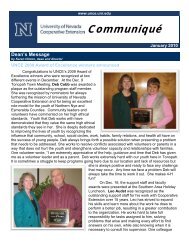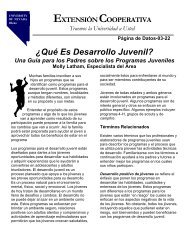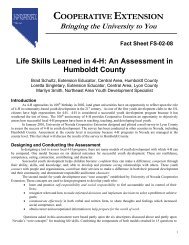Bed Bugs are Back! - University of Nevada Cooperative Extension
Bed Bugs are Back! - University of Nevada Cooperative Extension
Bed Bugs are Back! - University of Nevada Cooperative Extension
Create successful ePaper yourself
Turn your PDF publications into a flip-book with our unique Google optimized e-Paper software.
<strong>Bed</strong> <strong>Bugs</strong> <strong>are</strong> <strong>Back</strong>!<br />
Photo by Gary D. Alpert, PhD, Harvard <strong>University</strong><br />
Jeff Jeppson, Vector-Borne Disease Specialist<br />
Environmental Health Services<br />
Washoe County Health District
Early Origins<br />
Early man likely picked up bugs in caves cohabited with bats<br />
Fossilized bugs g have been found at archaeological g sites dating g back 3550<br />
years. – Egypt<br />
Genetic analysis indicates split between bat bugs and bed bugs may have<br />
occurred as far back as Homo neanderthalensis/Homo erectus (Balvin<br />
2011)
<strong>Bed</strong> Bug History<br />
<strong>Bed</strong> bugs were probably more <strong>of</strong> an issue for permanent settlements as<br />
opposed to nomadic tribes.<br />
As civilization spread so did the bugs.<br />
With the development and implementation <strong>of</strong> modern heating methods<br />
such as radiators, forced air, electric fans, etc. residences became the<br />
perfect environment for bed bugs to thrive year round.
<strong>Bed</strong> Bug History<br />
By the 1930s and 1940s bed bugs had the potential to become a<br />
community wide problem<br />
It has been estimated that up to 1/3 <strong>of</strong> households in Europe had<br />
some degree <strong>of</strong> infestation by this time<br />
Photo courtesy <strong>of</strong> E.J. Gerberg
<strong>Bed</strong> Bug History<br />
With the development <strong>of</strong> pesticides such as<br />
DDT and Malathion bed bugs were<br />
virtually eliminated in the U.S. U S following WWII WWII.
Why the resurgence?<br />
Insecticide Resistance?<br />
many pesticides <strong>are</strong> no longer effective against bed<br />
bugs, many populations <strong>are</strong> highly resistant to<br />
pyrethroid th id based b d insecticides*<br />
i ti id *<br />
reports <strong>of</strong> resistance to DDT noted as early as the<br />
1940s**<br />
*Romero, A (2007) Insecticide Resistant <strong>Bed</strong> <strong>Bugs</strong>:<br />
Implications for the Industry Industry. PCT July Issue 42-50 42-50.<br />
**Busvine, J (1958) Insecticide Resistance in <strong>Bed</strong> <strong>Bugs</strong>.<br />
BBulletin ll ti <strong>of</strong> f th the WHO 19(6) 19(6): 1041 1041–1052.<br />
1052
Why the resurgence?<br />
Increased international travel?<br />
Infestations first appe<strong>are</strong>d in hotels<br />
Move from spray pesticides to bait pesticides for<br />
roaches, ants, etc.?<br />
Sprays provided some control <strong>of</strong> “non-target” pests<br />
and also left a residual<br />
Some organophosphates and carbamates<br />
Some organophosphates and carbamates<br />
effective against bed bugs<br />
NOT APPROVED FOR INDOOR USE!!!!
Infestations on the Rise<br />
Washoe County Health District<br />
Environmental Health Services<br />
permitted hotels/motel complaints<br />
20<br />
doubled in 2005 due to bed bug calls. 10<br />
0<br />
Anderson, A. (2008). <strong>Bed</strong>bug<br />
Infestations in the News: a Picture<br />
<strong>of</strong> an Emerging Public Health<br />
Problem in the United States.<br />
JJournal l <strong>of</strong> f EEnvironmental i t l HHealth lth<br />
120<br />
110<br />
100<br />
90<br />
80<br />
70<br />
60<br />
50<br />
40<br />
30<br />
2006<br />
2004 2005 2006 2007
Where <strong>are</strong> infestations showing up?<br />
hotels and motels<br />
single family homes<br />
assisted living centers<br />
university dorms public transit<br />
child c<strong>are</strong> facilities<br />
movie theaters<br />
dry cleaners<br />
multi-family multi family housing<br />
homeless shelters<br />
nursing homes<br />
hospitals<br />
public schools<br />
laundromats
<strong>Bed</strong> Bug Biology
<strong>Bed</strong> Bug Biology<br />
Maturation rate depends on the temperature<br />
5 weeks to 4 months<br />
J. Austin, , Texas A & M <strong>University</strong> y<br />
At 70 F., 40 adult bed bugs in a room on May 2 will<br />
multiply y to 5,905 bugs g by y Nov. 2. (M. ( Potter, 2007) )
Adult bugs<br />
Reddish brown, size <strong>of</strong> a lentil<br />
Flat as a credit card when unfed<br />
After feeding, increase in size with<br />
After feeding, increase in size with<br />
elongated, rounded abdomen
Bite Reactions Vary<br />
Usually show up as welts<br />
Some individuals show no welts (30% to 50%)<br />
Welts may not show up for 4-5 days post-bite<br />
Dr. Harold Harlan, AFPMB
Delayed reaction ( > 24 hours)<br />
Dr. Harold Harlan, AFPMB
Some biting facts<br />
Host does not feel the bite<br />
Feeding eed g completed co p eted in 3 – 15 5 minutes utes<br />
Takes a blood meal every 3 – 7 days<br />
Most Most active from 1 am to 6 am<br />
Adults can live more than a year without feeding<br />
Gary D. Alpert, Harvard <strong>University</strong>
More biting facts<br />
Line feeding <strong>of</strong>ten noted<br />
<strong>Bugs</strong> may probe more than once to<br />
find a capillary.<br />
Bites may look like a rash (multiple<br />
probing shows up as tiny,<br />
red marks)<br />
Ph Photo t b by G Gary D D. Al Alpert, t<br />
Harvard <strong>University</strong><br />
Photo by Keah Schuenemann,<br />
Colorado <strong>University</strong> at Boulder<br />
Can travel up to 100 feet in a<br />
night but <strong>are</strong> usually found<br />
within 8 feet <strong>of</strong> host<br />
sleeping <strong>are</strong>a.
Fletcher et al. 2002<br />
Bites from heavy<br />
infestations
Public Health Issues<br />
Not known to vector any disease at this time.<br />
Secondary Secondary infection possible from scratching scratching,<br />
e.g. MRSA (Burnett, 1986)<br />
Anaphylaxis (Thomas 2004)<br />
Potential for blood from killed bugs g to transmit<br />
hepatitis B virus (7 days) and<br />
hepatitis C virus (4 days)<br />
Killed bugs only, not bites
Public Health Issues<br />
Reported associated health problems include<br />
discomfort, ,p psychological y g stress, , loss <strong>of</strong><br />
sleep, exacerbation <strong>of</strong> cardiac problems,<br />
indigestion, etc.
Accurate<br />
Identification<br />
is Critical
Other biting insects can be<br />
found in the home<br />
spider<br />
bbody d lice li<br />
mosquito<br />
bat<br />
bug<br />
flea tick
Related Species<br />
Cimex pilosellus<br />
Cimex lectularius Oeciacus vicarius<br />
“Bat Bug” g “Common <strong>Bed</strong> Bug” g “Swallow Bug” g
“Bat Bat <strong>Bugs</strong> <strong>Bugs</strong>”<br />
Pipistrellus hesperus<br />
(Western Pipistrelle bat)<br />
Collected in Carson City, NV 2011<br />
“Bat Bat bug” bug – aclose a close<br />
relative <strong>of</strong> the <strong>Bed</strong> bug.<br />
Cimex pilosellus in<br />
western US
Don’t diagnose g on bites<br />
B<strong>Bed</strong> d bbug bit bites can<br />
look like bites<br />
ffrom other th insects<br />
i t
Delusions <strong>of</strong> Parasitosis<br />
Ekbom’s Syndrome<br />
• Toxic Psychosis – Usually drug induced<br />
(Methamphetamine)<br />
( p )<br />
Removal <strong>of</strong> the cause removes symptoms<br />
• Paranoia or Melancholia – Sometimes<br />
iinduced d d bby onset t <strong>of</strong> f menopause or stress. t<br />
Delusion can become “fixed” with poor<br />
prognosis<br />
i
Locating g bugs g can be difficult<br />
Identification <strong>of</strong> the bugs confirms the source <strong>of</strong> the problem<br />
Get pr<strong>of</strong>essional identification. e.g. health department,<br />
pest control operator (PCO), agriculture department,<br />
cooperative p extension service, ,<br />
etc.
<strong>Bed</strong> bug signs that<br />
you might see<br />
Fecal spots<br />
Blood smears<br />
Cast skins (5 molts)<br />
Adult bugs<br />
Nymphal bugs<br />
Eggs
Cast skins<br />
Rusty blood<br />
smears<br />
The most common signs<br />
Fecal spotting<br />
Photos by J. Austin, Texas A & M <strong>University</strong>
The most difficult to see<br />
Eggs and egg cases<br />
1 mm long grain <strong>of</strong> rice<br />
cemented in place<br />
First stage nymph<br />
“Dust that moves”<br />
The size <strong>of</strong> a small<br />
speck <strong>of</strong> dust
Where they hide<br />
behind base molding<br />
2004, M. Potter, U. <strong>of</strong> Kentucky<br />
mattresses<br />
and box<br />
springs<br />
Inside a recessed<br />
screw cavity
Eggs and first stage nymphs<br />
in a ffurniture ffold
More hiding places<br />
Stuffed furniture Clutter under and around<br />
beds
In low level infestations<br />
<strong>Bugs</strong> <strong>are</strong> especially difficult to identify<br />
People <strong>of</strong>ten think they <strong>are</strong> being bitten by<br />
mosquitoes mosquitoes, spiders spiders, or fleas<br />
Nymphal bed bug feeding
Seem to appear suddenly in a living space,<br />
especially bed rooms or where people sleep
“Brood Brood Center Center”<br />
Concentrated pockets with<br />
bugs, fecal stains, eggs, egg cases, and cast skins
“Sometimes it is<br />
possible to destroy a<br />
light infestation by<br />
thorough soaking <strong>of</strong> the<br />
bed and other places<br />
with ith hi high-test h t t gasoline li<br />
….” (Hunter, 1938)<br />
NOT RECOMMENDED!!!<br />
Always Use<br />
RRegistered i t d<br />
Products!<br />
Read and Follow the<br />
Labeled Directions!<br />
Use Precautions!
Control and prevention<br />
Established infestations <strong>are</strong><br />
extremely t l diffi difficult lt tto eradicate di t<br />
With full tenant cooperation,<br />
complete bed bug elimination<br />
~88% 88% <strong>of</strong> the time<br />
With t ti<br />
Without cooperation<br />
~12% <strong>of</strong> the time
Control and Prevention<br />
Early identification is essential to effective<br />
prevention and control!
Control and Prevention<br />
Inspect p for bugs g pre p and<br />
post treatment<br />
A good apartment<br />
inspection typically takes 1<br />
to 2 hours<br />
A small cluster <strong>of</strong> bugs, a<br />
few eggs or a few nymphs<br />
cannot be missed<br />
2004, M. Potter, <strong>University</strong> <strong>of</strong> Kentucky
Control and Prevention<br />
Zippered encasements for mattress and box springs
Control and Prevention<br />
Metal bed frames – less favorable to bed bugs<br />
Keep clutter to a minimum in the bedroom
Control and Prevention<br />
Interceptors<br />
<strong>Bed</strong> bugs<br />
don’t jump or fly<br />
Place mineral oil or<br />
food grade DE in tray
Control and prevention<br />
p<br />
Don’t remove dwellers from their<br />
living space!<br />
The bugs can (and will)<br />
migrate to find a new host<br />
Single family home have<br />
been encased and<br />
fumigated up to 4 times and<br />
still have bed bugs
Control and Prevention<br />
vacuum – bag and dispose<br />
<strong>of</strong> contents in outdoor trash<br />
hot steam – use in<br />
cracks <strong>of</strong> furniture<br />
and mattress folds<br />
AFPCB
Control and prevention<br />
p<br />
The mattress and bed spring p g –<br />
To throw away or not throw away?<br />
Use best judgment. Holes? Tears? Brooding site?<br />
If the mattress must go, treat it first<br />
Wrap in plastic to carry to dumpster<br />
Spray paint “<strong>Bed</strong> <strong>Bugs</strong>” on infested items<br />
LLock k th the ddumpster t
Control and prevention<br />
Bag g up p clutter for<br />
treatment and removal<br />
Bag up all clothing,<br />
bedding, rugs, drapes and<br />
wash in hot water<br />
Good room preparation is the key to<br />
successful control!
Control and prevention<br />
p<br />
Wash bedding, clothes, etc. in<br />
hot water and dry on high<br />
heat<br />
Put tennis shoes, back packs<br />
in a dyer at medium heat for<br />
at least 5 minutes<br />
Do this while room is being<br />
treated
Non-Chemical Control<br />
Heat treatments<br />
Heat chambers or whole<br />
room/unit<br />
Temperatures must reach<br />
~113° F to kill nymphs/adults<br />
y p<br />
~115° F to kill eggs<br />
Cold treatments<br />
Death point variable,<br />
~0° F<br />
Carbon Dioxide (atmospheric)<br />
– 30% CO2 for 24 hours at<br />
77°F (Wang et. al. 2012)
Chemical Control<br />
Use an integrated approach (IPM)<br />
Due to resistance already developed pesticides should be<br />
viewed as the last means <strong>of</strong> control control.<br />
Pesticides should only be applied after other means <strong>of</strong> control<br />
have been implemented.<br />
http://cfpub.epa.gov/oppref/bedbug/<br />
Know Know your products<br />
Read the label<br />
Read the MSDS<br />
Apply accordingly
Control and Prevention<br />
2007 2007, J. J Austin, A ti Texas T A & M <strong>University</strong><br />
U i it<br />
Think in 3D<br />
In hotels, motels, and apartments, all rooms surrounding<br />
infested <strong>are</strong>a should be treated
The biggest gg obstacle to<br />
effective control…<br />
Clutter!
The Health District standard<br />
for determining if a room is<br />
bed bug free<br />
No bites and no bugs for 60 days post-treatment!
<strong>Bed</strong> bugs <strong>are</strong> expert hitchhikers<br />
2004, M. Potter, U. <strong>of</strong> Kentucky
Protect<br />
Yourself<br />
Mi Minimize i i what h t you<br />
take in the room with<br />
you
Protect<br />
Yourself<br />
Don’t Don t sitona sit on a bed bed,<br />
s<strong>of</strong>a, or s<strong>of</strong>t chair.<br />
Find a hard<br />
surface to sit on on.
Protect<br />
Yourself<br />
Leave items in a<br />
black plastic garbage g g Wash in hot water or place in dryer at<br />
bag in the hot sun.<br />
medium heat for 5 minutes
Protect<br />
Yourself<br />
Luggage Rack<br />
Suitcase Encasement
Future <strong>of</strong> <strong>Bed</strong> <strong>Bugs</strong>… <strong>Bugs</strong><br />
Infestations will be common for the foreseeable future<br />
Lack <strong>of</strong> effective pesticides with residual<br />
Lack <strong>of</strong> knowledge<br />
Many pesticides no longer approved for indoor use<br />
Greater percentage <strong>of</strong> population on fixed income
Future <strong>of</strong> <strong>Bed</strong> <strong>Bugs</strong>… <strong>Bugs</strong><br />
Non-Chemical Control<br />
• Heat, cold, CO 2, encasements, interceptors, etc.<br />
NRS 118a<br />
Units must be bed bug ffree at time <strong>of</strong> f commencement<br />
<strong>Bed</strong> <strong>Bed</strong> Bug language in lease agreements
Future <strong>of</strong> <strong>Bed</strong> <strong>Bugs</strong>… <strong>Bugs</strong><br />
Infestations will continue to be most common in<br />
low income multi-unit housing<br />
– Often lower pr<strong>of</strong>it margins for PCOs<br />
– Treatments can be expensive<br />
– Time consuming
Future <strong>of</strong> <strong>Bed</strong> <strong>Bugs</strong>… <strong>Bugs</strong><br />
If it’s stupid and it works, it isn’t stupid
If An<br />
Emergency<br />
Should<br />
Occur ……<br />
Please Call<br />
Us Us.<br />
We Can Help Help.
Questions?

















